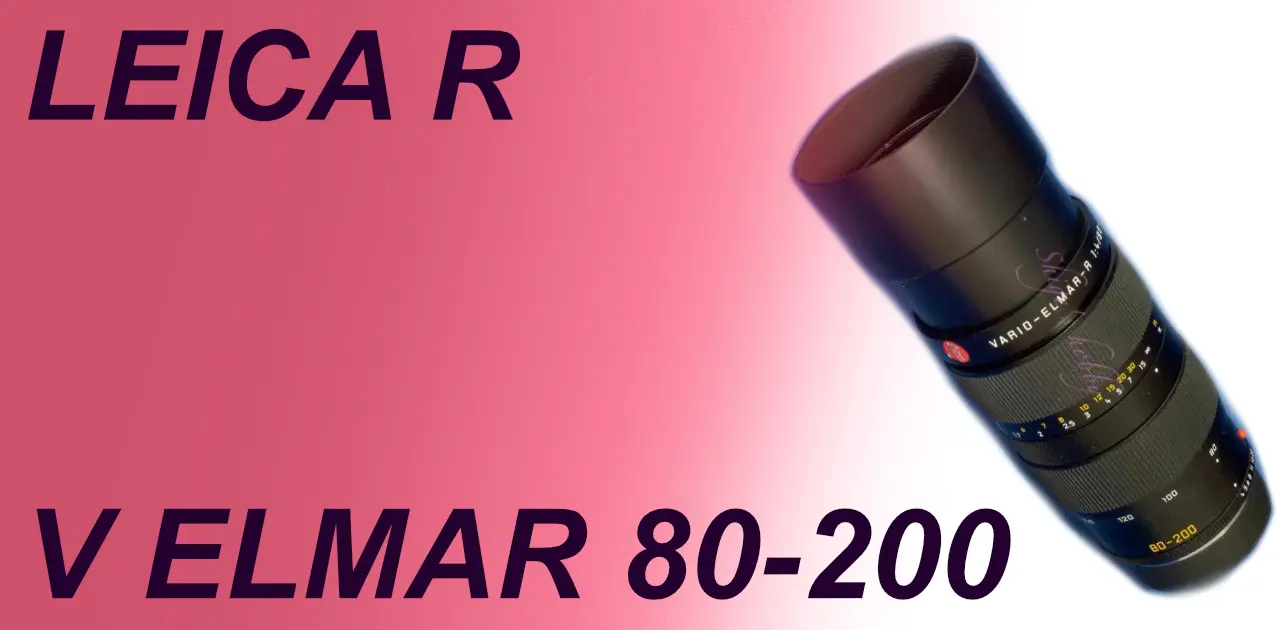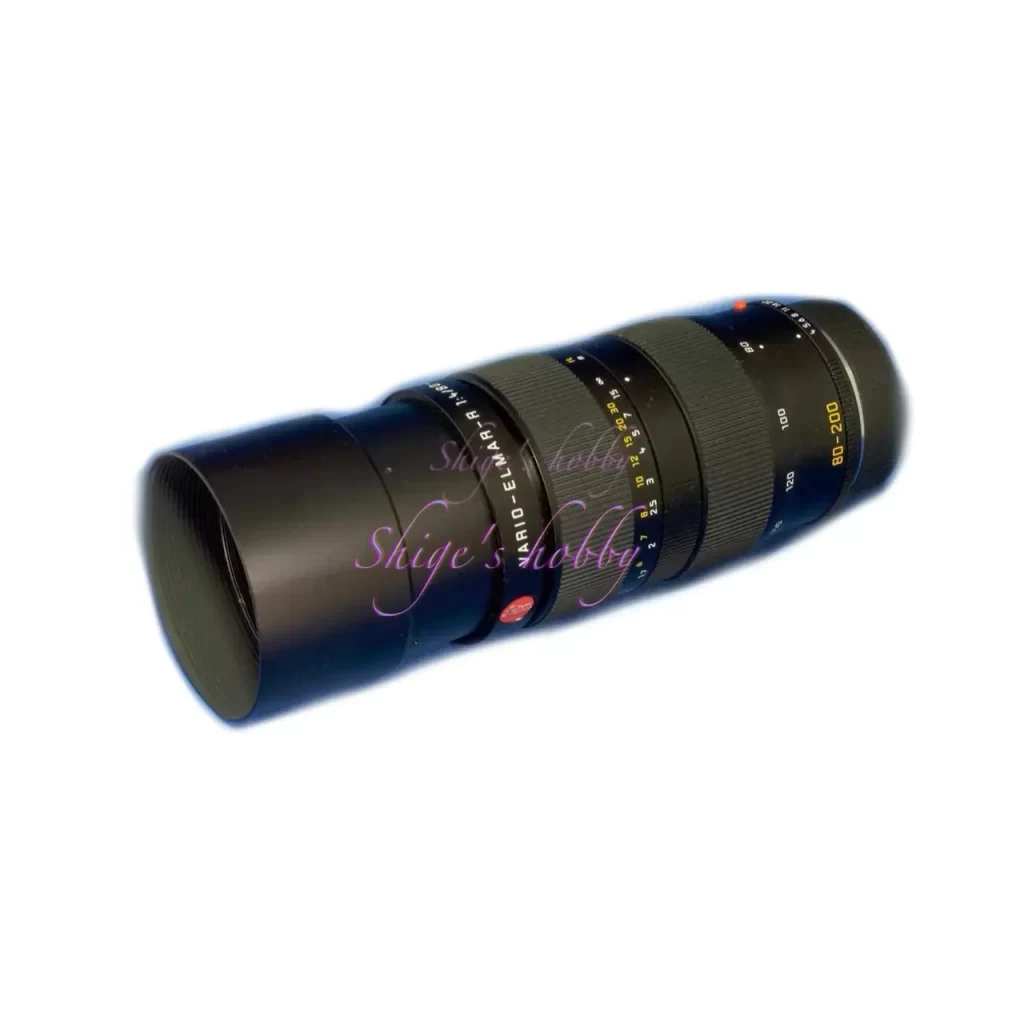Cloudy Telephoto Zoom VARIO ELMAR R 80-200mm F4

A review and photo examples of the Vario Elmar 80-200mm F4.
Table of contents
Gallery
- Gallery / LEICA SL typ601 /LEICA M-P typ240
Review

1.Overview
The Leica Vario-Elmar 80-200mm F4 is a medium telephoto zoom lens with a constant F4 aperture for the Leica R mount, released in 1995 or 1996.
The drawback of this lens is that the middle element is prone to balsam cutting and clouding. That is why the title is “Cloudy Telephoto Zoom VARIO-ELMAR R 80-200”.
Detailed specifications are listed in the table, but the main specifications are summarized below.
- Focal length 80mm~200mm
- Lens configuration 12 elements in 8 groups
- Rotating zoom
- Minimum focusing distance 1.1m all range
- Filter diameter 60mm
- Hood built-in
The version with ROM terminal (order number 11281) can control TTL flash with the LEICA R8 and R9. In addition, when the lens is connected to a LEICA L digital camera using the DMR (Digital Module R) and the genuine mount adapter LEICA R-ADAPTER L (order number 16076), in addition to flash control, information such as lens name, aperture value, focal length, and for some lenses, shooting distance can be transmitted to the camera, and this information can be recorded in the exif of the image file.
The version for the R cam only is order number 11280.
It seems that Kanto Camera Service accepted repairs for lens fogging around 2022, but it is necessary to contact Kanto Camera Service to see if it is still possible at this time. Foggy lenses are sold at a very low price, but considering the repair costs, it may be better to look for a normal product from the beginning, but it is quite difficult to find a normal product.
2.Usability
The lens controls of the VARIO ELMAR 80-200mm F4 are standardized for Leica R-mount rotary zooms, with the zoom ring at the base and the focus ring in the middle.
As you can see from the sample images, the bokeh is beautiful among zoom lenses, and although the minimum shooting distance is 1.1m, it is not a lens that can get close, but it is also suitable for nature photography. I sometimes wish it could get as close as 0.7m, but I gave up on the idea because it was a trade-off with the convenience of a zoom lens. It is possible to attach a macro adapter, so you can use that if you really want to get close.
Despite being a manual focus lens, it uses a two-ring system with separate zoom and focus controls, so you need to operate the zoom and focus separately, which can be a bit troublesome to operate during shooting. As expected, two-ring zoom lenses are designed to be used with autofocus.
From the outside, it looks like an internal zoom, but the overall length of the lens changes slightly when you turn the focus ring. The lens hood is built-in and can be used by pulling out the tip, but since it is not pulled out very far, the hood length does not seem to be long enough at 200mm. The lens barrel is decorated with the Leica red badge, which is unique to zoom and telephoto lenses, and matches the cylindrical lens barrel design.
The F4 aperture is not an issue when used during the day, and although the slim lens feels difficult to hold when attached to a larger camera, the advantage of being lightweight and easy to carry makes it easy to use in the field.
3.Summary
In conclusion, to sum up the VARIO ELMAR 80-200mm F4 is a compact telephoto zoom lens with a constant F4 aperture.
The image quality is fine for a zoom lens, but although it is a manual focus lens, it uses a two-ring rotation method, and since you need to operate the zoom and focus separately, it can feel cumbersome to operate.
Specification
The Leica Vario-Elmar 80-200mm F4 has had three lenses with the same focal length released in the past, and this lens is the latest, fourth-generation model.
Previous Leica R-mount medium telephoto zoom lenses have used a linear zoom that allows focus and focal length to be changed with a single action. The fourth-generation Leica Vario-Elmar 80-200mm F4 uses a two-ring rotating zoom with separate focus and zoom rings.
This two-ring rotating zoom mechanism is suitable for autofocus lenses, where the zoom ring is operated manually and the camera is responsible for focusing, and it is difficult to see any advantages with manual-focus Leica R-mount lenses.
When Leica created a new zoom lens in 1995, they adopted a rotating zoom lens that was difficult to use with manual focus. This lens was released at a time when Japanese autofocus cameras were dominating the camera market, and the latest zoom lenses being renewed were increasingly switching to two-ring rotating types, while no manufacturers were using linear zoom lenses at all.
A typical example is Nikon’s Ai AF Zoom Nikkor ED 80-200mm F2.8S, released in 1988, which was a linear zoom, and its successor, the Ai AF Zoom Nikkor ED 80-200mm F2.8D (New), released in 1996, which switched to a rotating zoom. Canon’s EF80-200mm F2.8L from 1989 was already a rotating zoom.
As rotary zooms were becoming mainstream at the time, it is possible that they were hesitant to adopt a linear zoom lens that was out of line with the times, or that when they ordered production from Japan, they did not have the equipment or craftsmen to make a linear zoom lens.
Like the VARIO ELMAR 35-70 F4, it is stamped “Made in Japan” and is said to have been manufactured by Kyocera.
There is the Vario Apo-Elmarit 70-180mm F2.8, which is brighter with a closer focal length, but it is about twice as heavy as this lens, making it a lens that you would hesitate to carry around casually.
| Lens name | VARIO ELMAR | ← | ← |
| Focal length(mm) | 21-35 | 35-70 | 80-200 |
| Max aperture | 3.5-4 | 4 | ← |
| Min aperture | 22 | ← | ← |
| Leaf blade | 6 | ← | ← |
| Lens Construction | 9elements in 8groups | 8elements in 7groups | 12elements in 8groups |
| Min distance(m) | 0.5 | 0.5 (0.26 macro) | 1.1 |
| Lens length(mm) | 66.3 | 79 | 46 |
| Max diameter(mm) | 75 | 74 | 62.5 |
| Filter Size(mm) | 67 | 60 | 60 |
| Weight(g) | 500 | 505 | 1020 |
| Lens hood | Plastic claw hood 12438 | Screw hood 12437 | Build in hood |
| Production number*1 | 3,400(Up to 2005) | 8,680(Up to 2005) | 14,350(Up to 2005) |
| Release date | 2001- | 1996- | 1995- |
Reference links
Update history
- 2025.1.19
- 2024.03.26
- 2023.11.16
Affiliate links
- Leica Lens・Ads by Amazon
- Leica Books・Ads by Amazon
- LEICA R used lens・Ads by Rakuten

Leave a Reply